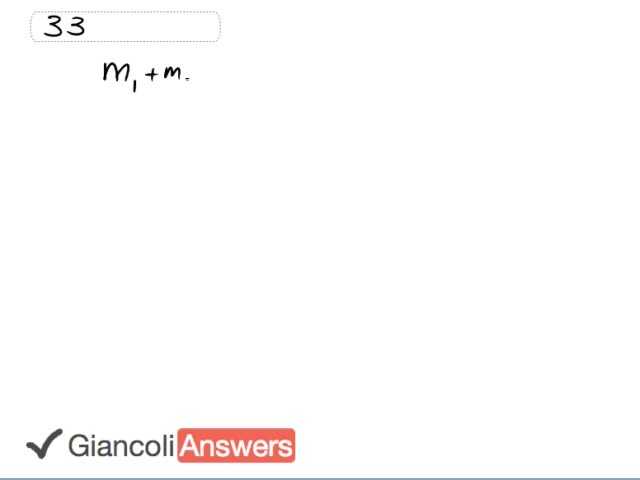

In order to watch this solution you need to have a subscription.
So we know that the total mass of these two objects ‘m1’ plus ‘m2’ is four kilograms. We also know the force of gravity between is two point five times ten raised to power minus ten newtons and the distance by them 'r' is zero point two five meters. The formula for gravity is: ‘G’ times ‘m1’ times ‘m2’ over 'r' squared and if we and if we solve ‘m1’ plus ‘m2’ is four for ‘m1’, we can make a substitution into the gravity equation. So we’ll say: ‘m1’ equals four kilograms minus ‘m2’ and then putting that in the gravity equation we'll have an equation with only one unknown. So we have: force of gravity ‘Fg’ is ‘g’ times four point zero kilograms minus ‘m2’ times ‘m2’ all over 'r' squared. Multiplying both sides by 'r' squared and simplifying we’ll end up with 'r' squared times ‘Fg’ equals negative ‘G’ times ‘m2’ squared plus ‘G’ times ‘m2’ times four. This is a quadratic equation so we’re going to use the quadratic formula to solve it: ‘G’ times ‘m2’ squared minus four times ‘G’ times ‘m2’ plus 'r' squared times ‘Fg’ equals zero. Dividing everything by ‘G’ we end up with: ‘m2’ squared minus four point zero times ‘m2’ plus 'r' squared times ‘Fg’ over ‘G’ equals zero. Substituting in the rest of the numbers and using the quadratic formula: ‘m2’ squared minus four point zero times ‘m2’ plus zero point two five squared times two point five times ten raised to power minus eleven equals zero. Simplifying further: ‘m2’ squared minus four point zero ‘m2’ plus zero point two three four two six equals zero. Referring to ‘a’ times ‘x’ squared plus ‘b’ times ‘x’ plus ‘c’ equals zero where ‘x’ equals plus or minus the square root of ‘b’ squared minus four times ‘a’ times ‘c’ all over two ‘a’, ‘a’ is one, four point zero is ‘b’ and zero point two three four two six is ‘c’ in this quadratic formula, so: ‘m2’ equals four point zero plus or minus the square root of four squared minus four times ‘c’, ‘a’ being one, all divided by two and that gives us that ‘m2’ is three point nine four kilograms. Since ‘m1’ is four point zero minus ‘m2’ then we know ‘m1’ has to be: four minus three point nine four which is zero point zero six kilograms.